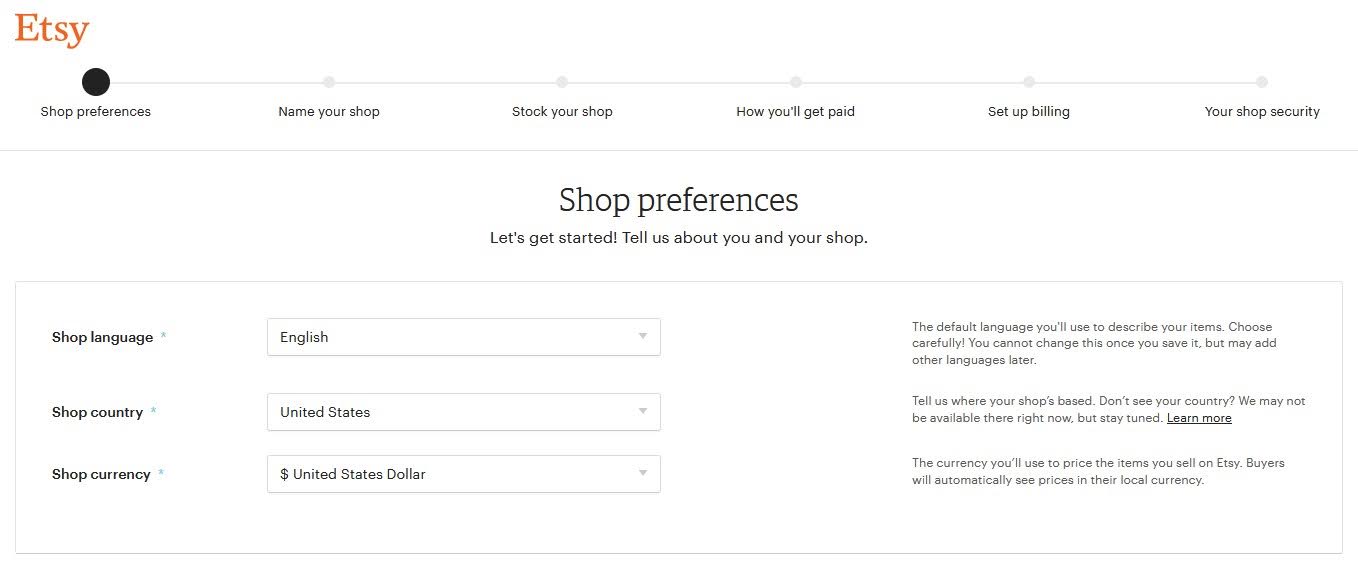Hey there, crafter! Do you find yourself daydreaming about turning your love for crafting into some extra cash? Well, today might be the day those dreams start to become reality. Trust me, you’ll want to read this blog before you take the plunge into becoming an Etsy seller!
Let’s talk about Etsy—the online marketplace where creativity and commerce collide. It’s one the best places for innate traffic to showcase your handcrafted items, vintage goods, and crafting supplies, connecting directly with buyers who appreciate the uniqueness of your creations. But hold your horses before you dive in! How would you like a little boost to kickstart your journey? I’ve got some awesome news for you. If you sign up for an Etsy seller account using our unique link, you’ll get 40 free listings to start your shop off strong. Yep, you read that right—40 free listings!
Starting an Etsy shop is as easy as clicking the link above and following the steps, but becoming a successful Etsy Seller with selling momentum is a lot more involved than guides may lead you to believe.
Table of Contents
Understanding Etsy
If you’ve heard of Etsy but aren’t quite sure what it’s all about, let me break it down for you. Etsy is an online marketplace that brings together sellers of unique, handmade, and vintage items. Unlike generic retail platforms, Etsy is designed specifically for the kind of work you love to do—crafting! It’s a place where individuality shines and quality is valued. This isn’t just any marketplace; it’s a community of like-minded people who appreciate the art of making. Simply put, Etsy provides you with an audience that already values creativity and craftsmanship, right from the get-go.

Why Choose Etsy Over Other Platforms?
Great, so now you know what Etsy is. But you might be wondering, “Why Etsy? Aren’t there other platforms where I can sell my crafts?” Absolutely, there are other platforms, but let’s talk about why Etsy could be the right fit for you:
- Built for Crafters: Unlike other platforms that cater to all sorts of sellers, Etsy focuses on handmade, custom, and vintage items. It’s tailor-made for crafters like you.
- Strong Community: Etsy is more than just a sales platform; it’s a community. You’ll find forums, teams, and plenty of resources to help you along your journey.
- SEO Benefits: Etsy has strong search engine optimization (SEO) capabilities. When people search for products like yours on Google, there’s a good chance an Etsy listing will appear in the results.
- Trust: Etsy has built-in trust factors like reviews, secure payment options, and a straightforward dispute resolution process. This makes buyers more comfortable making a purchase.
- Global Reach: Your crafts can be seen and bought by people from all over the world, not just those in your local community.
- Built-in Traffic: By far the biggest benefit to selling on Etsy is that you capitalize on Etsy’s existing traffic. When you build your own website you’re responsible for driving all of your own traffic there via various methods like SEO, paid advertising, or social media channels. With an Etsy shop, you can still do these things while still benefitting from Etsy’s existing traffic.
- Ease of Use: The platform is designed to be user-friendly. Setting up a shop and listing products is straightforward, especially for those who may not be tech-savvy.
Etsy is not just another platform; it’s a specialized marketplace that offers you a unique advantage as a crafter. Etsy is a fantastic way to get your feet wet in selling your crafts online, which you can then use as a springboard to create your own standalone website.
If you’re anything like me, you’re probably buzzing with excitement to start your Etsy journey, especially with those 40 free listings in your pocket. But wait, let’s pump the brakes for a second. Jumping in without some basic preparation is like crafting without a pattern. Sure, you might end up with something cool, but your chances of success are much higher with a little planning.

Preparation Before You Start Selling on Etsy
Don’t worry, we’re getting to the fun part of actually creating your Etsy store. But a few simple steps now can save you a lot of time and stress down the line.
Market Research
If you’re considering selling your crafts, it’s not enough to just love what you do; you also need to know that there’s a demand for what you’re making and how to position your brand. Market research is your best friend in this phase. Here’s how to break it down:
Niche Selection:
Choosing your niche is like laying the foundation for your business. Being specific will help you target the right audience.
- Research Tools: Utilize platforms like ERank or Google Trends to analyze which crafts are currently in demand.
- Consumer Needs: Look at customer reviews on similar products to understand what buyers are looking for.
- Unique Value Proposition: Identify what sets your crafts apart. Is it the quality, the design, or perhaps a unique material?
Competitor Analysis:
Take a look at some of the top sellers in your category. What are they doing right? This isn’t about copying what others are doing. It’s about understanding the market landscape.
- Top Sellers: Identify who the top sellers in your niche are. Analyze their shop layout, product photography, and customer reviews.
- Sales Volume: Some Etsy shops display the number of sales they’ve made, which can give you a rough idea of the demand.
- Product Variety: Note the range of products they offer. Does it make sense for you to offer variations as well?
When you’re doing your competitor analysis you might find a number of shops with items that are infringing on copyrighted material. Just because their shop is selling Taylor Swift items, does not mean you should. Copyright infringement will eventually lead to your store getting shut down. It might seem tempting to try and get some quick sales this way - but it’s not the right way to get sales.
Pricing Strategy:
Knowing your competitors will help you price your products competitively. Too high and you might drive away potential buyers; too low and you might not make a profit.
- Cost Analysis: Take into account the cost of materials, time spent crafting, and overhead costs like electricity or any specialized tools.
- Competitive Pricing: Check how similar items are priced. This will give you a ballpark range for your own pricing.
- Profit Margin: Always remember that fees will be taken from the selling price, so make sure to factor in a profit margin that makes the effort worthwhile.
Trend Spotting:
Keep an eye on seasonal trends or any trending crafts that you might be able to incorporate into your own unique items. Staying updated on trends ensures your shop remains relevant.
- Seasonal Trends: Holidays, seasons, and events can all influence what people are looking to buy. For example, knitted items might sell better in the winter.
- Social Media: Platforms like Pinterest and Instagram are great for spotting up-and-coming trends.
- Etsy’s Own Trends: Etsy often releases trend reports. Use these to your advantage to offer items that are currently in the limelight.

Costs Involved
The downside of selling on Etsy compared to a standalone site is the associated fees. Let’s talk about what it’ll cost you to sell on Etsy.
- Listing Fees: Once you’ve used up your 40 free listings, it costs $0.20 to list an item for four months or until it sells.
- Transaction Fees: Etsy takes a 5% fee on the sale price, including the cost of shipping.
- Payment Processing Fees: These vary depending on the location of your bank. In the US, it’s 3% plus $0.25 per transaction. Payment processing fees come into play whether you’re selling on Etsy or your own website.
- Optional Fees: These include services like Etsy Ads or Etsy Plus, which come at additional costs but offer features like custom URLs or restocking alerts.
- Shipping Fees: Once you’ve sold an item you’ll have to ship it. Don’t let shipping fees catch you off guard. I recommend doing some “mock” sales to get an accurate package dimension and weight to get associated shipping costs that you can charge the buyer or bake into your selling price.
Having a grasp of these costs beforehand will allow you to price your items appropriately and decide on a budget for any optional features or advertising.
You can use a free service like Pirate Ship to help you when it comes to calculating and buying shipping labels. Not only does it integrate directly with websites like Etsy, but they also provide fantastic rates on USPS and UPS packages. I am not affiliated with them but I have had nothing but awesome experiences in using them for my shipping labels.
Setting Up Your Etsy Shop
Alright, now that you’ve got a solid understanding of what you’re diving into and you’re equipped with insights on your market and costs, it’s time to get down to the fun part—setting up your own Etsy shop. Trust me, it’s simpler than you think!

Creating Your Etsy Seller Account
First things first, you’ll need to set up your Etsy seller account. Now remember, if you use our special link to create your account, you’re getting 40 free listings to jumpstart your Etsy journey. Here’s how to get started:
- Click on our unique link to head over to the sign-up page.
- Enter Your Email Address: You’ll start by entering a valid email address and creating a password to go with it.
- Continue through the workflow and you’ll have to name your shop. Your shop name needs to be between 4-20 characters and can’t have special characters, spaces, or accented letters. Etsy has a guide in their Seller Handbook that has tips for choosing your Etsy shop name.
- Once you’ve come up with a name for your shop Etsy puts you directly into creating your first listing. Unfortunately, you can’t proceed from this step without creating the listing.
- Choose Payment Methods: Etsy offers various ways to accept payments, like Etsy Payments, which is the primary way to accept payments and includes options like credit cards and Etsy Gift Cards.
- Set Up Billing: Here you’ll enter your billing information for any fees outside of your 40 free listings.
Remember, this isn’t just about opening an Etsy shop; it’s about opening your small business empire. Those 40 free listings mean you can experiment with different products and find what resonates with your audience without worrying about listing fees. So don’t miss out—make sure you use our unique link when you sign up.
Customizing Your Etsy Shop
Once you have your Etsy seller account up and running, the next step is to give your shop some personality. Here’s how to make your shop visually appealing:
- Shop Banner and Icon: Think of this as your shop’s storefront. A compelling banner and icon can make a strong first impression.
- Shop Announcement: This is a brief message that any visitor to your shop will see. Use it to introduce your brand, announce sales, or highlight any unique features about your crafts.
- Shop Sections: Organize your products into different sections like ‘Handmade Jewelry,’ ‘Home Decor,’ or ‘Wedding Gifts.’ It makes for easier navigation for your buyers.
- Item Descriptions: Take your time crafting detailed and accurate descriptions for each item. Use bullet points for easy scanning.
- Photography: Invest in good-quality photos that show your product from multiple angles. Good photography can be the difference between a sale and a pass.
- Tags and Titles: Use relevant keywords in your product titles and tags to make them more discoverable. This is SEO 101 and it’s crucial for being found in Etsy’s search engine.
Customizing your shop is not just about aesthetics; it’s also about functionality and making the shopping experience as smooth as possible for your customers. A well-organized, visually appealing shop can help you build credibility and encourage visitors to spend more time (and money) in your shop.
Listing Products for Sale on Etsy
After you’ve set up your shop and customized it, your next task is to start listing additional products. Etsy recommends that you start with listing at least 5 from the start, but the more high-quality listings you put out the more you’re likely to get sales. The two major pillars for a successful listing are top-notch product photos and the strategic use of SEO and keywords.

Tips for Good Etsy Product Photography
Visuals are incredibly important when selling online; after all, customers can’t touch or try your product. That’s why it’s crucial to invest in quality photography.
Natural Lighting: Natural light is your friend. It can bring out the true colors and details in your product.
Multiple Angles: Show your item from different perspectives to give a full picture of what buyers will receive.
Context: Show the item in a setting where it would be used, to help buyers visualize it in their own life.
Close-ups: Highlight any intricate details or unique features with close-up shots.
Consistency: Keep the background and style consistent to give your shop a cohesive look.
Great photos not only make your listing more attractive but also build trust by showing that you pay attention to detail. Sometimes the product description can be hard for buyers to find on Etsy, so your pictures need to be able to represent the products you’re selling.
SEO and Keywords
Search engine optimization (SEO) is not just for websites; it’s important for your Etsy listings as well. Proper SEO ensures that your products show up in both Etsy and Google searches.

How to Use Keywords Effectively:
- Research: Use tools like ERank to find out which keywords are popular in your niche.
- Strategic Placement: Include your most important keywords in the title, tags, and within the first few lines of the product description.
- Long-Tail Keywords: These are longer phrases that shoppers are likely to use when looking for something very specific. They may have less search volume, but they also have less competition.
- Relevance: Make sure the keywords you use are highly relevant to your product. Irrelevant keywords can lead to more views but fewer sales.
- Update Regularly: Trends change, and so should your keywords. Keep an eye on your analytics to see which keywords are driving traffic and adjust as needed.
In summary, your product listings are your virtual sales pitches. High-quality photos capture attention, while effective SEO practices make sure that attention comes your way. Both are integral to turning browsers into buyers on your Etsy shop.
Making Your First Etsy Sale
So you’ve set up your Etsy store and listed your first products — congratulations! But your work is just beginning. Getting eyes on your shop is the next crucial step, and there are several strategies you can use to drive traffic:
Utilize Family and Friends: When you’re first starting out, it can be worthwhile to post your shop to your network of friends who can place your first couple of orders. Not only does this give you a trial run on filling orders and shipping them, but it will help give your shop credibility. If you go this route, be sure to ask them to leave genuine reviews, and get feedback on how you might improve their experience as a buyer.
Social Media: Leverage platforms like Instagram, Pinterest, and Facebook to showcase your products and connect with your target audience. Think about your target audience and where they are hanging out and likely to find you – then spend your efforts creating a social media following on that platform.
Etsy Ads: Etsy offers an advertising platform that can boost your product listings’ visibility. I don’t recommend using Etsy advertising right from the beginning. Spend your time perfecting your listings before you start spending money to promote them. When you’re ready, budget carefully, and start small to test the waters.
Influencer Partnerships: Collaborate with influencers who resonate with your brand and can authentically promote your products to their followers.
SEO: You’ve optimized your product listings, but don’t forget about your shop description and other shop-level SEO opportunities.

Customer Service
A one-time customer can become a repeat customer if you provide outstanding customer service. Here’s how:
- Prompt Communication: Always respond to customer queries and issues as quickly as possible.
- Customization: Offer personalization or customization for your products to make the customer feel special.
- Packaging: Thoughtful packaging not only protects your product but also enhances the customer’s unboxing experience.
- Follow-Up: After a sale, reach out to customers to ask for feedback and offer future promotions.
Becoming a Successful Etsy Seller
Common Mistakes to Avoid
Selling on Etsy is an exciting journey, but there are pitfalls you should steer clear of.
- Poor Quality Photos: Poorly lit or cluttered photos can deter potential buyers.
- Ignoring SEO: Not optimizing your listings can result in low visibility.
- Overpricing or Underpricing: Either can dissuade customers or eat into your profits.
- Ignoring Shop Policies: Not having clear return, shipping, and payment policies can lead to misunderstandings with customers.
Tips for Long-Term Success
Success on Etsy is far from an overnight achievement; it’s a marathon, not a sprint. Here’s how to keep the momentum going:
- Regularly Update Listings: Keep your shop fresh with new products and seasonal items.
- Analyze Traffic and Sales Data: Use Etsy’s analytics tools to understand what’s working and what’s not.
- Reinvest Profits: Put a portion of your earnings back into the business for advertising, product development, or other growth opportunities.
- Expand Beyond Etsy: Once you’ve established a solid customer base, consider diversifying your sales channels, like starting your own website.
Conclusion
Congratulations! You’ve just navigated through the essentials of starting your journey on Etsy — from understanding what the platform is all about, to setting up your shop and listing your first product. While there’s more to learn and explore, this guide hopefully sets a solid foundation for you to build upon.
Don’t forget, if you sign up for an Etsy seller account using our unique link, you’ll kickstart your business with 40 free listings. It’s a great way to get your products out there without any initial costs for listings. Start your Etsy journey today and turn your crafting ideas into income.

No comment yet, add your voice below!